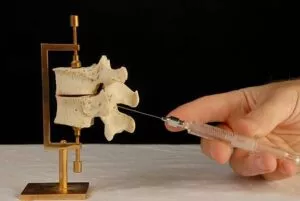The Southwest Scoliosis and Spine Institute’s doctors use Facet Joint Blocks to stop pain generated by the spine. This nonevasive procedure works well.
Facet Joint Block
 Southwest Scoliosis and Spine Institute’s board-certified, fellowship-trained orthopedic physicians: Richard Hostin, MD, Devesh Ramnath, MD, Ishaq Syed, MD, Shyam Kishan, MD, and Kathryn Wiesman, MD, have years of experience treating thousands of patients with complex spine conditions. In order to learn the cause of the patient’s pain, the doctor may utilize a few different tests. Also, the treatment plan will always start with a conservative plan — like a facet block.
Southwest Scoliosis and Spine Institute’s board-certified, fellowship-trained orthopedic physicians: Richard Hostin, MD, Devesh Ramnath, MD, Ishaq Syed, MD, Shyam Kishan, MD, and Kathryn Wiesman, MD, have years of experience treating thousands of patients with complex spine conditions. In order to learn the cause of the patient’s pain, the doctor may utilize a few different tests. Also, the treatment plan will always start with a conservative plan — like a facet block.
For your information, the facet block procedure consists of a local anesthetic and steroid. This combination gets injected directly into the suspected source of the pain. In this case, the injection will hopefully reduce the inflammation in the joint space of the spine.
Facet joint block, also known as facet joint injection or medial branch block, is a minimally invasive procedure. Our doctors commonly use this procedure to diagnose and treat pain originating from the facet joints in the spine. This webpage provides a detailed overview of the facet joint block procedure. It includes the conditions that warrant its implementation, the method of administration, and the expected duration of pain relief.
Indications for Facet Joint Block
Facet joint blocks are typically recommended for individuals experiencing persistent pain in the spine, specifically in the facet joints. The facet joints are small joints located between the vertebrae. The provide stability and movement of the spine. Conditions that may lead to facet joint pain and prompt a doctor to consider a facet joint block include:
- Facet Joint Arthritis: Also known as facet joint osteoarthritis, involves the degeneration of the facet joints. The cause is usually due to wear and tear, leading to inflammation, stiffness, and chronic pain.
- Facet Joint Syndrome: This refers to pain and dysfunction in the facet joints caused by injury, repetitive strain, or stress on the spine.
- Facet Joint Sprain: Sports injuries or car accidents can result in significant pain and limited mobility by spraining or straining facet joints.
- Facet Joint Degeneration: When facet joints degenerate and bone spurs form, chronic pain can occur along with reduced spinal mobility.
- Facet Joint Block Procedure: The facet joint block procedure involves the following steps:
Patient Preparation
The patient is positioned on an examination table, and the skin over the targeted facet joint is cleaned and sterilized.
- Local Anesthesia: A local anesthetic numbs the skin and underlying tissues at the injection site. This ensures minimal discomfort during the procedure.
- Fluoroscopic Guidance: A fluoroscopy, a real-time imaging technique, guides the placement of the needle into the facet joint.
- Injection Administration: A mixture of local anesthetic and anti-inflammatory medication, such as a corticosteroid, is injected into the facet joint. Doctors can also inject the medicine into the surrounding nerve branches (medial branches). This medication aims to alleviate pain, reduce inflammation, and provide diagnostic information.
- Post-Injection Observation: After the injection, the staff will monitor the patient for a short period to assess any immediate response or potential side effects.
Duration of Facet Joint Block
The duration of pain relief from a facet joint block can vary from person to person. It depends on factors such as the underlying condition being treated, the individual’s response to the medication, and the specific medications used. Typically, the effects of a facet joint block can be classified into two phases:
- Diagnostic Phase: Shortly after the procedure, if the facet joint block provides significant pain relief, it serves as a diagnostic tool to confirm that the facet joints are the source of the pain. The duration of pain relief during this diagnostic phase is relatively short, usually lasting a few hours to a day.
- Therapeutic Phase: The therapeutic effects of a facet joint block usually develop a few days after the procedure and can last for several weeks or months. The anti-inflammatory medication injected into the facet joint helps reduce inflammation, alleviate pain, and improve overall function.
It’s important to note that the duration of pain relief is variable, and individuals may experience varying degrees of relief based on their unique circumstances. If the facet joint block provides significant and long-lasting pain relief, it may indicate the potential benefits of further treatments, such as radiofrequency ablation, to provide more extended pain relief.
Conclusion
Facet joint blocks are valuable procedures for diagnosing and managing pain originating from the facet joints in the spine. By administering medication directly into the affected joint or surrounding nerves, facet joint blocks can provide both diagnostic and therapeutic benefits. The procedure is relatively safe and minimally invasive, offering relief from facet joint-related pain and improving the overall quality of life for individuals experiencing chronic spinal pain. If a patient is considering a facet joint block, the patient should consult with a spine care professional like the doctors at the Southwest Scoliosis and Spine Institute who can evaluate the patient’s condition and determine if this procedure is appropriate.
Why Make an Appointment with the Southwest Scoliosis and Spine Doctors
The Southwest Scoliosis and Spine Institute is a private medical practice located in three locations in Dallas, Plano, and Frisco, Texas. The practice specializes in the diagnosis and treatment of spinal conditions, including scoliosis, kyphosis, and other spinal deformities. Furthermore, the Institute offers a variety of treatment options, including surgical and non-surgical approaches.
The Southwest Scoliosis and Spine Institute maintains a team of highly experienced and skilled spine surgeons. These doctors have received specialized training in the diagnosis and treatment of spinal conditions. Therefore, they use the latest techniques and technologies to ensure the best possible outcomes for their patients. Combined they have seen 100,000 patients and performed surgery on 16,000 of them.
The Institute’s approach to spine treatment centers on the patient, meaning that the doctors and staff approach each patient differently. Moreover, they work closely with their patients to understand their individual needs and goals and develop a customized treatment plan that takes into account the patient’s unique situation, lifestyle, and preferences.
The Institute also offers comprehensive follow-up care and support to its patients. This includes physical therapy and rehabilitation, to help them recover quickly and fully from their surgery.
____________________
Radiology Info: Facet Joint Block
If you or a loved one suffers from spinal pain, you owe it to yourself to call Southwest Scoliosis and Spine Institute at 214-556-0555 to make an appointment.


